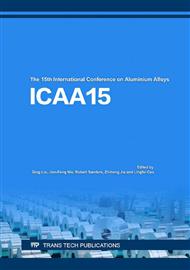[1]
S. Karabay, Influence of AlB2 compound on elimination of incoherent precipitation in artificial aging of wires drawn from redraw rod extruded from billets cast of alloy AA-6101 by vertical direct chill casting, Mater. Des. 29(7) (2008) 1364-1375.
DOI: 10.1016/j.matdes.2007.06.004
Google Scholar
[2]
J. E. Hatch, Aluminum: Properties and physical metallurgy, ASM International, (1984).
Google Scholar
[3]
L. P. Wang, F. W. Kang, G. Erjun,X. Y. Zhang, Role of Single Rare Earths Ce , La and Mischmetal in Commercial Pure Aluminum, J. Chinese Rare Earth Soc. 21(2) (2003) 218-221.
Google Scholar
[4]
F. Q. Li, The interaction of borium with the impurity elements in aluminum alloys and it effect on the conductivity, Master degree thesis, Dalian University of Technology, (2003).
Google Scholar
[5]
S. Karabay, I. Uzman, Inoculation of transition elements by addition of AlB2 and AlB12 to decrease detrimental effect on the conductivity of 99. 6% aluminium in CCL for manufacturing of conductor, J. Mater. Process. Techn., 160(2) (2005) 174-182.
DOI: 10.1016/j.jmatprotec.2004.06.015
Google Scholar
[6]
H. C. Liao, Y. Liu, C. L. Lü, Q. G. Wang, Effect of Ce addition on castability, mechanical properties and conductivity of Al-0. 3%Si-0. 2%Mg alloys, Int. J. Cast. Metals Res. 28(4) (2015) 213-220.
DOI: 10.1179/1743133615y.0000000002
Google Scholar
[7]
C. L. Lü, H. C. Liao, Y. Liu, Q. G. Wang, Effect of Ce addition on castability, mechanical properties and conductivity of commercial-purity aluminum, China Foundry 12(4) (2015) 277-284.
Google Scholar
[8]
G. Z. Gao, Y. W. He, J. Z. Chen, Influence of rare earth on conductivity of aluminum conductors, Chinese J. Nonferrous Met. 2(1) (1992) 78-81.
Google Scholar
[9]
Y. H. Xu, S. L. Wang, S. Tian, F. M. Du, X. P. Zhou, F. S. Ni, Effect of Ce on the aging of AlMgSi alloy by resistance measurement, J. Rare Earths 13 (3) (1995) 186-189.
Google Scholar
[10]
N. Q. Zhao, J. X. Yao and X. J. Yang, Effect of Rare Earth on Microstructure and Properties of 6063 Aluminum alloy, J. Tianjin Univ. 28(3) (1995) 375-379.
Google Scholar
[11]
W. P. Chen, Y. F. Zhu and X. G. Zhang, Researching rare earth-aluminium alloy with it to make heat resistant cable which has high-strength and high conductivity, J. Kunming Metallurgy College 12(1, 2) (1996) 16-27.
Google Scholar
[12]
J. H. Yan, H. H. Chen, Effect of the heat treatment on the strengthen and electrical conductivity of 6063 aluminum alloy, Hot Working Techn. (2) (2004) 49-50.
Google Scholar
[13]
M. C. D. Andersen, Further results on the nucleation of precipitates in the Al-Zn-Mg system, Acta Metall. 47 (1966) 1009-1012.
Google Scholar
[14]
M. Murayama, K. Hono, Pre-precipitate clusters and precipitation processes in Al–Mg–Si alloys, Acta Mater. 47(5) (1999) 1537-1548.
DOI: 10.1016/s1359-6454(99)00033-6
Google Scholar
[15]
D. Pashley, M. Jacobs, J. Vietz, The basic processes affecting two-step ageing in an Al-Mg-Si alloy, Philosophical Magazine, 16(139) (1967) 51-76.
DOI: 10.1080/14786436708229257
Google Scholar
[16]
H. C. Liao, Y. N. Wu, K. Ding, Hardening response to rapid aging processes and precipitation in Al-7%Si-0. 3%Mg alloy. ICAA13: 13th International Conference on Aluminum Alloys, John Wiley & Sons, Inc., 2012, pp.1113-1118.
DOI: 10.1002/9781118495292.ch167
Google Scholar
[17]
H. C. Liao, Y. N. Wu, K. Ding, Hardening response and precipitation behavior of Al–7%Si–0. 3%Mg alloy in a pre-aging process. Mater. Sci. Eng. A, 560 (2013) 811-816.
DOI: 10.1016/j.msea.2012.10.041
Google Scholar
[18]
X.L. Li, J. H. Chen, C. H. Liu, J. N. Feng, S. H. Wang, Effect of T6 and T78 tempers on the microstructures and properties of Al-Mg-Si-Cu alloys, Acta Metall. Sinica, 49(2) (2013) 243-250.
DOI: 10.3724/sp.j.1037.2012.00509
Google Scholar


